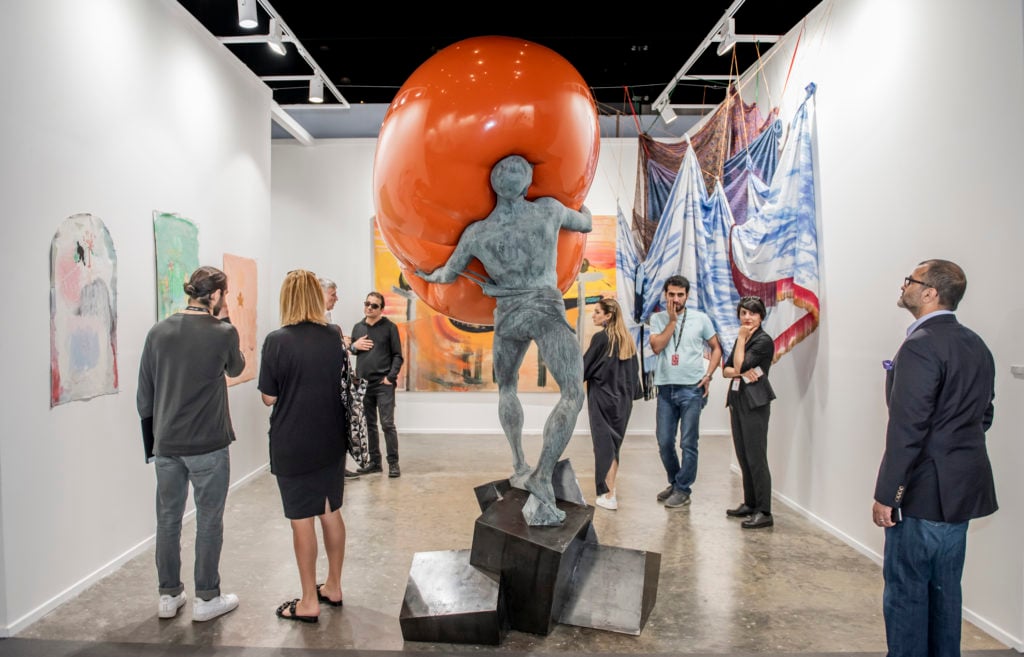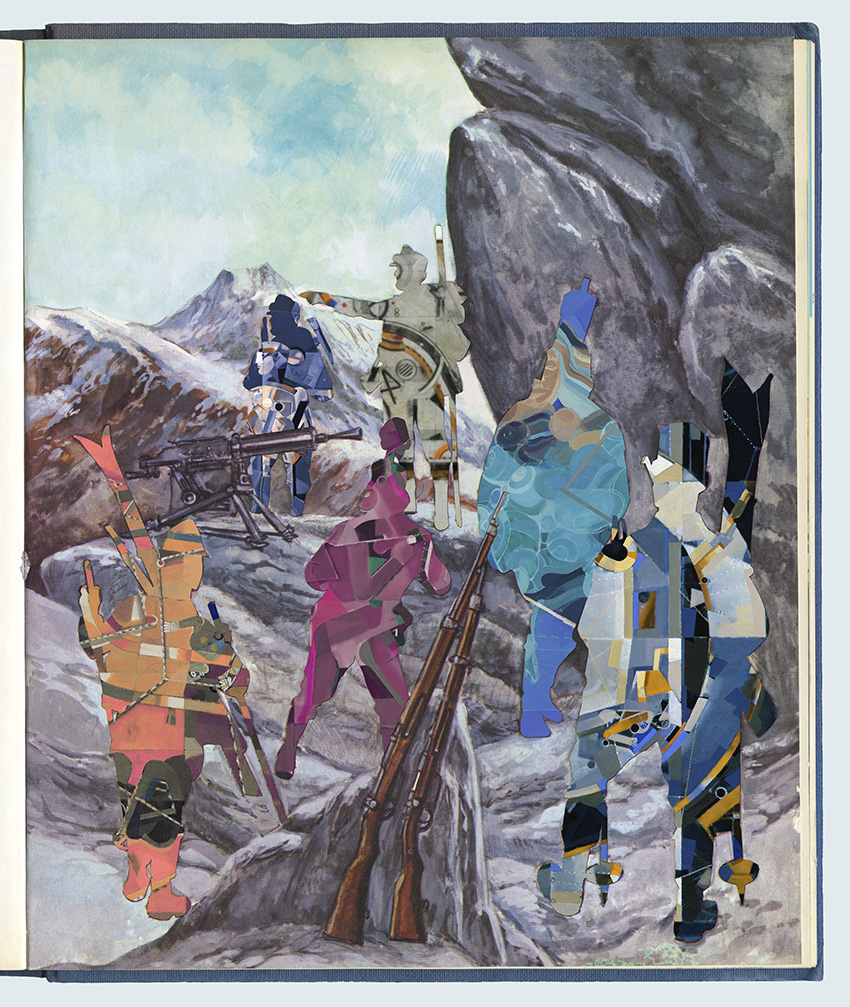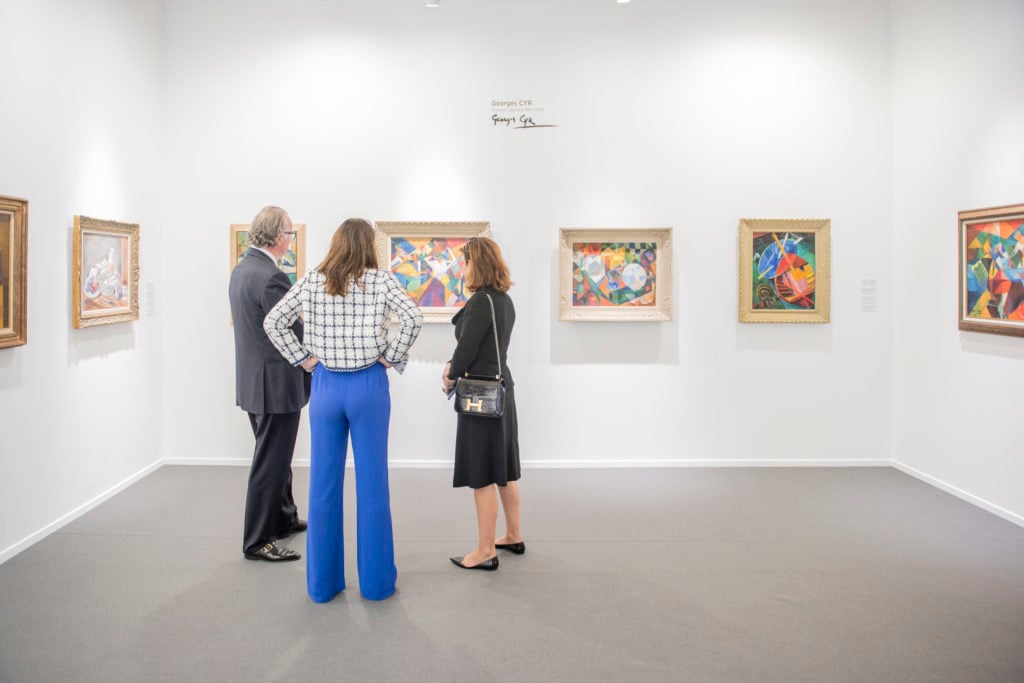Art Fairs
Amid a Gloomy Economic Forecast and Simmering Political Tensions, Art Dubai Tries to Find Stability
The fair opened under a cloud this week, but some exhibitors have remained optimistic.

The fair opened under a cloud this week, but some exhibitors have remained optimistic.

Rebecca Anne Proctor

The sculpture is impossible to miss.
At this year’s edition of Art Dubai, right at the front entrance to the booth of the Tehran-based gallery Dastan’s Basement, there is a work by Mohammad Hossein Gholamzadeh titled Farewell to Proserpina (2019). It depicts a man grasping a large orange weight, and is inspired by Gian Lorenzo Bernini’s 16th-century sculpture Rape of Proserpina.
“He’s trying with all his might to hold this heavy load—a bit like our situation now,” the owner of Dastan’s Basement, Hormoz Hematian, told artnet News. “This work is indicative of the rough terrain that we are in—of Iran and the wider region.”
Although the gallery sold the work for $20,000 to an Iranian collector, expectations were not high when the 13th edition of the fair opened to VIP collectors on March 19 in the United Arab Emirates’s shiny metropolis.
The economic forecast has been gloomy. While no official recession has been announced in the UAE, there are whispers of a looming plunge not unlike the one of 2009. In November, Dubai posted its biggest job loss since the global financial crisis a decade ago. On top of that, a continued blockade against Qatar, the UAE’s involvement in the war in Yemen, and a softening retail market have led to diminished economic confidence.
“You can feel that we are passing through very difficult times,” said Andrée Sfeir-Semler, owner of Sfeir-Semler Gallery in Beirut and Hamburg, and a regular exhibitor since Art Dubai’s inception on the penultimate day of the fair. “The Saudis obviously didn’t come, the Qataris didn’t come, and almost no Kuwaitis came. And from Europe, we had visitors, but not as many as usual. It is one of the most difficult years for us. We made sales but not as we were hoping to, and not like in previous years.”
Among the gallery’s star works were colorful inkjet works by Walid Raad alongside paintings by Etel Adnan in the range of $35,000. “Expensive works were not easy to sell,” Sfeir-Semler said. “It is when people are comfortable with their politics and economic situation that they think about buying art—when they are relaxed. The situation at the moment is very tough politically and economically.”

Walid Raad’s Samir Khaddaj (2018), a pigmented inkjet print, was at the Sfeir-Semler Gallery boot at Art Dubai.
Art Dubai has also faced trouble. In September, fair organizers ended their decade-long sponsorship agreement with the Abraaj Group, a private equity firm that quickly became an influential emerging-market investor and the Middle East’s biggest private equity dealmaker. It also famously collapsed in just four months at the end 2018 into a pool of around $1 billion of debt that liquidators are still seeking to settle.
The fair’s tight relationship with Abraaj was pivotal in the creation of the Abraaj Group Art Prize, the first of its kind in the Middle East, annually awarding $100,000 to a winning artist from the region.
For months there were rumors about whether the fair would continue at all in such a shaky regional market. “The relationship with Abraaj had reached its tenure; it was coming to an ending,” said Pablo del Val, Art Dubai’s artistic director. “Maybe we would have renewed. We don’t know.”
His new team has made considerable changes to this year’s fair—changes that have endowed it with a fresh new look and a more spacious floorplan. This year’s edition is smaller in size, featuring 92 galleries after last year’s record 103 participants, and for the first time, the Modern and Contemporary art sections have been integrated.
“When I took over and Chloe [Vaitsou, formerly of the Frieze Art Fair] came on board, there were obvious changes to be made,” del Val said. “We needed to shift things and create sections that could engage the public in different ways.” These include Bawwaba, which means “gateway” in Arabic, dedicated to 10 solo presentations showcasing works created within the last year or conceived specifically for the fair by artists from the Middle East, Africa, Latin America, and Central and South Asia.
UAE Now, another new segment, features works by local artists and collectives. “It’s really unfortunate when people come to the UAE and say that there is no culture and everything is imported,” said the section’s curator, Munira Al Sayegh. “UAE Now is a direct response to that.”
The second edition of the Residents section, a project inviting international artists for a six to eight week residency in the UAE, placed the spotlight on Latin America. A bright psychedelic orange sculpture with black drips of oil could be found at Barro, a gallery from Buenos Aires. The work, made by artist Nicanor Araoz, incorporated oil from the UAE in an attempt to create a “new universe.”
The gallery sold two drawings for $10,000 each. “We are trying to access a new market,” said the gallery’s Federico Curutchet. “This is the first time we are meeting curators from Turkey and the UAE.”

Visitors to the Elmarsa Gallery booth at Art Dubai 2019. Courtesy of Photo Solutions.
On average, prices ranged from a few thousand dollars to a few hundred thousand. “What’s exciting about Art Dubai is that you have very different price points that are not just for the top top collectors,” Vaitsou said. “The fair opens up a space for emerging collectors.” And despite the dark cloud hovering over Art Dubai, exhibitors displayed smiles and enthusiasm on the fair’s VIP preview day. Some even reported near sell-outs of their booths.
Addis Fine Art sold two paintings by prominent Ethiopian artist Tadesse Mesfin for $28,500 each to local collectors. Galerie Templon sold works by Chiharu Shiota, Sudarshan Shetty, and Ivan Navarro to regional and international collectors for prices ranging from from €20,000 to €115,000. At Dubai’s Custot Gallery, a sculpture by Sophia Vari sold for $125,000 to a local collector.
“We’re selling well,” said Charles Pocock of the Dubai-based Meem Gallery. “The local market has grown. We’ve had our clients come in from Bahrain and elsewhere buying works by Huguette Caland (around $15,000), Etel Adnan ($2,800), Kamal Boullata, and Dia Azzawi.”
“Is the fair looking at the local market or the international market?” asked Dubai-based entrepreneur and collector Hashem Montasser. “I don’t have an answer but there seems to be a desire to breed a new set of regional and younger collectors through price points that are more modest than compared to other fairs. And this is a good thing.”
“It’s been grim for the last few years,” said London-based Indian collector Gulpreet Kohli. “This year they put on a good show. The challenge here is that unless you get local collectors to support the scene, people like us who come and go will never be able to build an art market.”